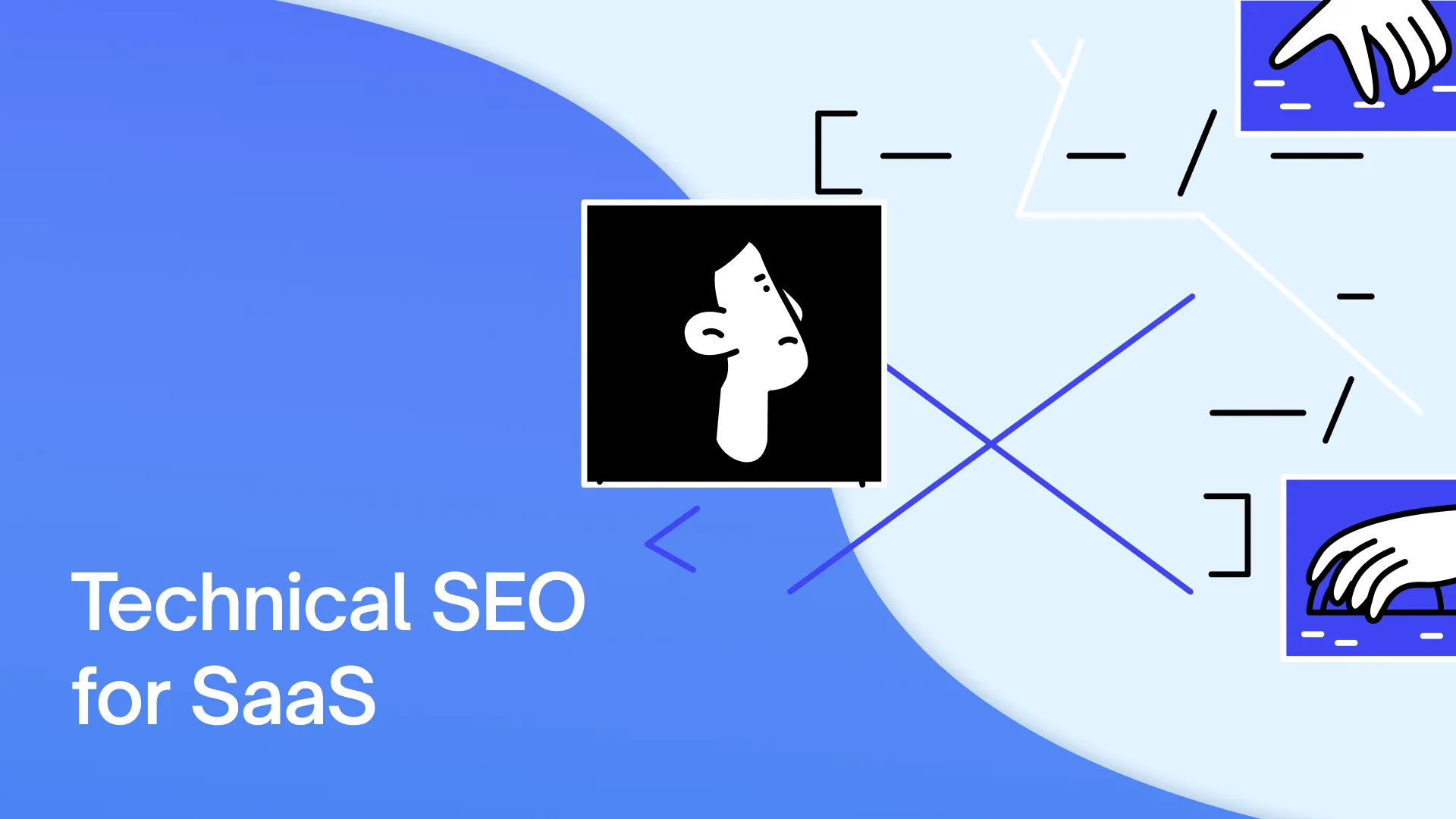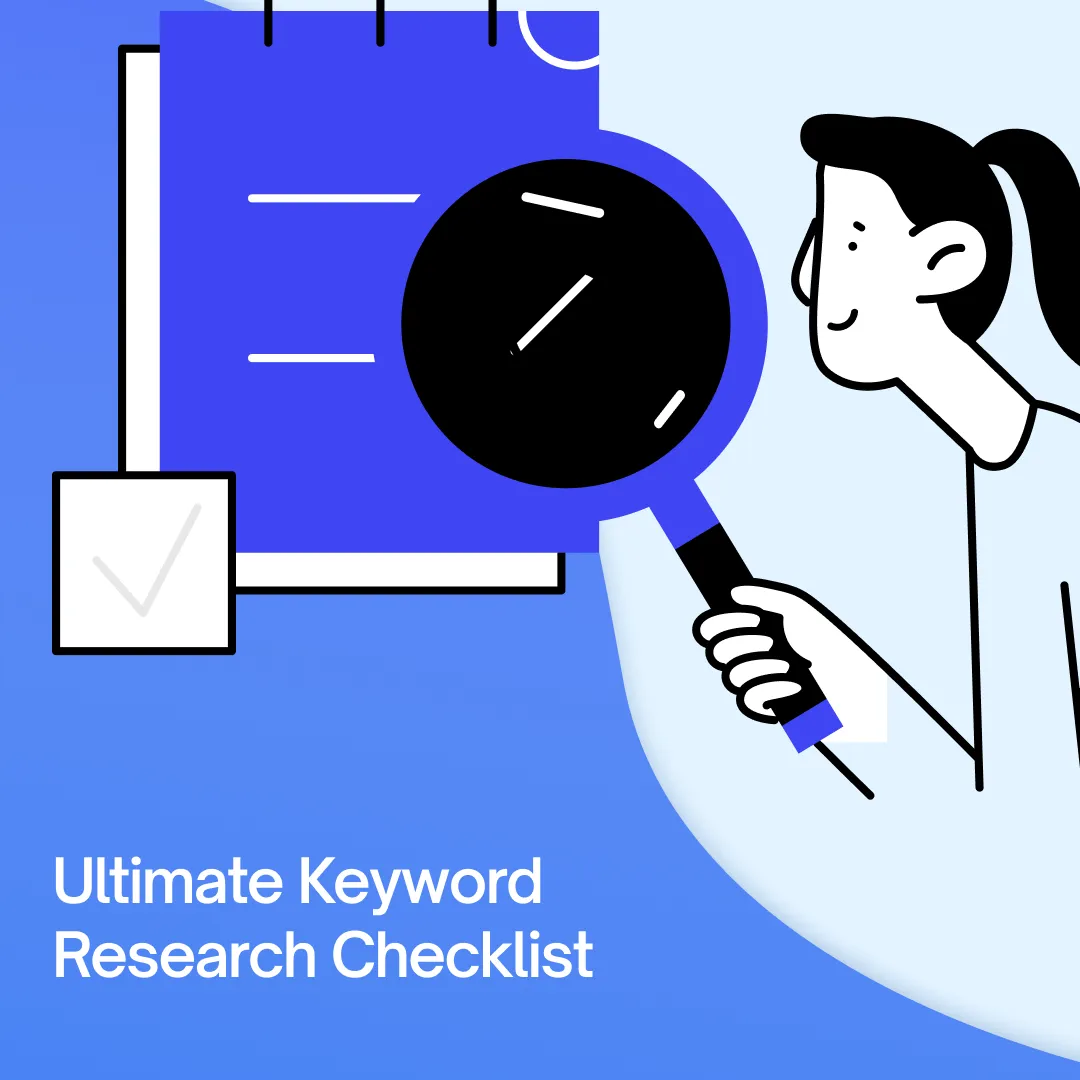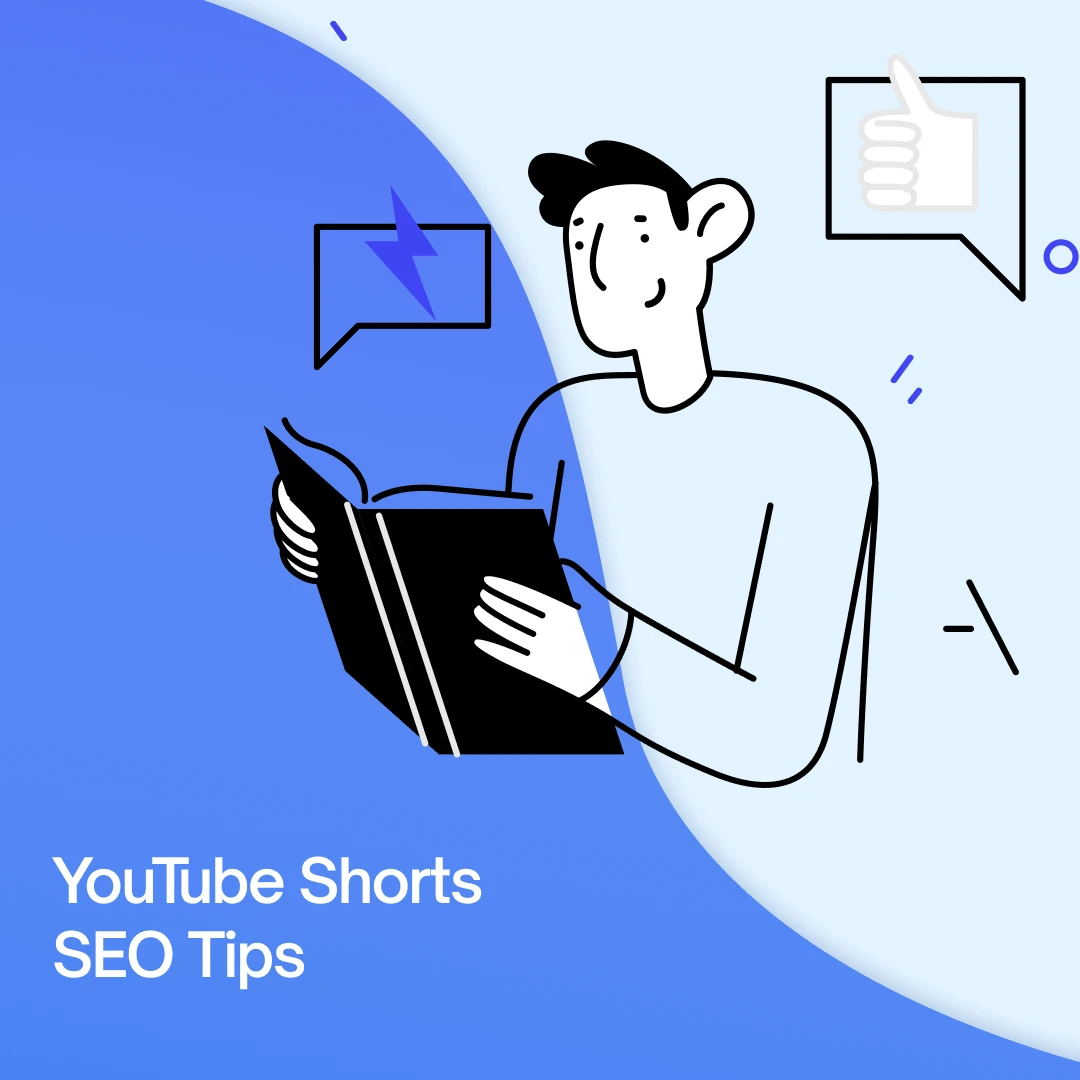If you run a SaaS company, you know growth comes from systems that scale. That goes double for website optimization.
In fact, 91% of marketers say SEO positively impacts their site’s performance.
And your SEO is only as strong as the technical foundation holding it up.
Here’s the thing: your website might look clean on the surface. But under it, slow load times, broken links, and crawl errors could be silently killing your visibility.
A fast, structured, crawlable site compounds every marketing effort: your blog, your product pages, your conversions. And investing in technical SEO for SaaS turns that foundation into a growth engine built for scale.
Let’s see what it takes to get there.
TL;DR
If you’re short on time, this is your technical SEO cheat sheet:
- Keep your crawl paths clean and your architecture logical.
- Watch your Core Web Vitals; speed kills (literally).
- Protect your structure with canonical tags, clean URLs, and smart indexing.
- Automate audits before errors get out of control.
- Treat SEO like infrastructure, instead of a marketing checkbox.
Use this checklist to keep your SaaS SEO stack fast, lean, and ready to scale.
Why Technical SEO Matters for SaaS?
SaaS websites move fast. You’re shipping updates, launching new features, expanding documentation, and optimizing onboarding. All while Google’s trying to figure out what your site is actually about.
Sustainable growth in SaaS starts with solid technical SEO; it aligns crawl budget, site architecture, and Core Web Vitals for stronger rankings and conversions.
But without strong technical SEO, Google’s crawlers struggle to keep up with your site structure, wasting crawl budget on outdated URLs instead of high-value pages.
As such, having a healthy technical setup helps search engine rankings and protects conversions. A clean crawl path means your sign-up pages load faster, your pricing stays indexable, and your product updates don’t break key links.
That’s how you scale visibility and revenue.
What the Numbers Tell Us About SaaS SEO ROI
Data doesn’t lie; SEO is now central to how SaaS brands grow and compete:
- Organic traffic still drives growth: For top SaaS companies, organic search makes up 26.4% of total site traffic.
- Businesses are all-in on SEO: In 2025, 60% of UK businesses made SEO part of their marketing strategy, mirroring a global trend across SaaS brands.
- SaaS SEO delivers real ROI: Done right, B2B SaaS SEO drives a 702% return on investment.
- Budgets are rising: SaaS companies increased their SEO spend by 7.2% in 2025, proof that organic growth is now treated like product investment.
- Technical debt is killing performance: 28% of SEO experts cite it as their top blocker, as shown in a 2025 report by Aira.
- Conversion is the new KPI: Aira’s report also notes that 49% of SEOs measure success by conversion rate, not rankings.
Here’s the main takeaway: the SaaS brands winning in search are fixing infrastructure. The rest? They’re stuck patching issues every quarter because SEO sits below engineering priorities.
If you want to scale, your technical SEO can’t be an afterthought. It’s the system that keeps everything else (content, UX, product) working together, instead of competing for crawl budget.
P.S.: Want to see how SaaS brands turn technical health into growth? Check out our guide on B2B SaaS SEO for the playbook behind scalable organic results.
A Practical Technical SEO Checklist for SaaS Websites
Let’s get practical. This is a SaaS-specific checklist built for scalability, not another “best practices” list. If you’re serious about ranking, your technical SEO strategy needs to evolve at the same pace as your product.
Below, you’ll find seven essentials every SaaS marketer and dev team should keep in sync. Let’s take a look.
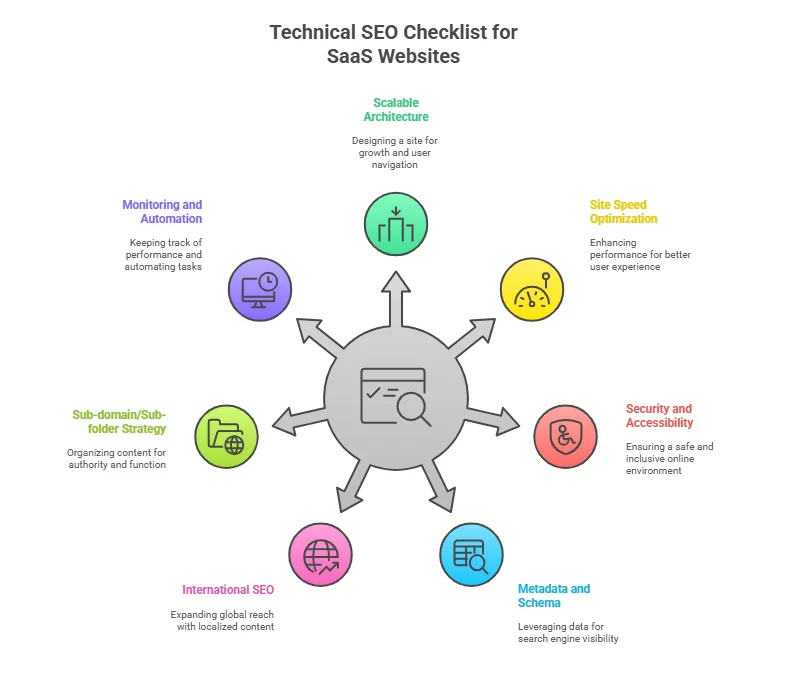
1. Design a Scalable Site Architecture That Grows With You
Your site architecture is your SEO backbone. When it’s messy, everything (from crawling to conversions) breaks down.
In SaaS, where product pages, blogs, and help docs grow weekly, your structure needs to support scale instead of creating chaos.
A strong hierarchy lets search bots understand where your key pages live, how they connect, and which deserve priority.
So, keep it structured, simple, and scalable:
- Build a clear hierarchy that mirrors your product, blog, and resource flows.
- Use human-readable URLs that reflect intent.
- Keep your XML sitemap dynamic; update it automatically with every new page.
- Control duplication with canonical tags.
- Strengthen internal linking to surface key product and pricing pages.
- Use robots.txt and noindex tags strategically to protect crawl budget.
Here’s why this matters: SaaS websites scale fast, but search engines don’t guess what’s important; you have to tell them.
For example, our client Axify uses canonical tags to help search engines understand which URLs represent the main version of a page.
On their DORA metrics guide (/blog/understanding-dora-metrics-complete-guide), the canonical tag explicitly points to the same clean URL. That’s how they’re signaling to Google that this is the authoritative version.
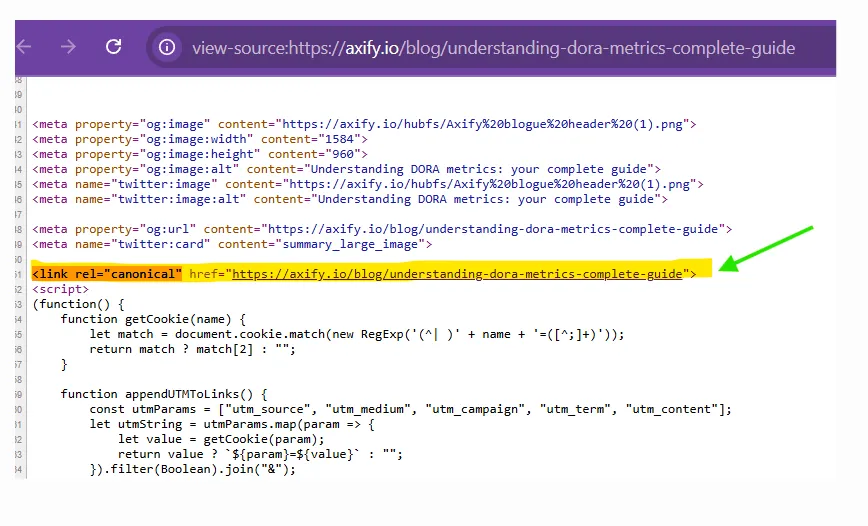
This prevents duplicate variations (like tagged URLs or campaign parameters) from splitting ranking signals and ensures consistent indexing across the site.
Also, a clean URL structure helps bots understand your content relationships.
Strong internal linking channels authority to your money pages and keeps new content discoverable without manual babysitting.
That’s why our content process includes strong writing guidelines, which emphasize internal links like these:
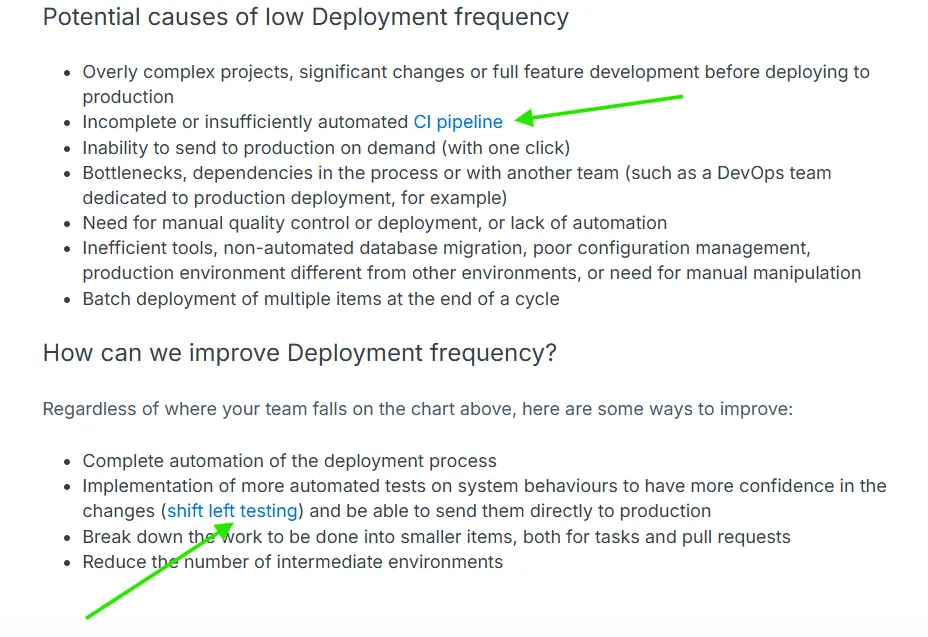
If your SEO feels “stuck,” 8 out of 10 times it’s because your site hierarchy isn’t supporting your growth. Fix that, and everything else becomes easier to rank.
2. Own Your Site Speed and Core Web Vitals
Speed is not a UX bonus anymore. Now, it is a growth metric.
When your SaaS website takes too long to load, you’re losing rankings, signups, trials, and MRR. Performance is one of those invisible levers that quietly amplifies (or sabotages) every marketing effort you make.
Here’s what to watch:
- Optimize for LCP, FID, and CLS; these are your three non-negotiables.
- Serve images through a CDN and compress them automatically.
- Manage JavaScript rendering (React, Vue, Next.js) so Google bots can crawl what users see.
- Use dynamic rendering or hydration to speed up interactive elements.
- Prioritize mobile optimization; responsive design and fast performance go hand in hand.
For example, Nova Cloud’s speed index affects its entire performance, even if its best practices are great. That decreases the site’s overall SEO score:

Now, some perspective: B2B SaaS SEO campaigns convert at an average 1.1% visitor-to-lead rate. You’ll want 2–5% if you’re serious about growth; in a lot of cases, that difference comes down to page loading time.
Here’s the kicker: performance fixes are rarely glamorous, but they have compounding returns. A site that loads 0.1 seconds faster can mean up to 10% more conversions for some niches.
Here’s how that change in speed affects the entire user journey:
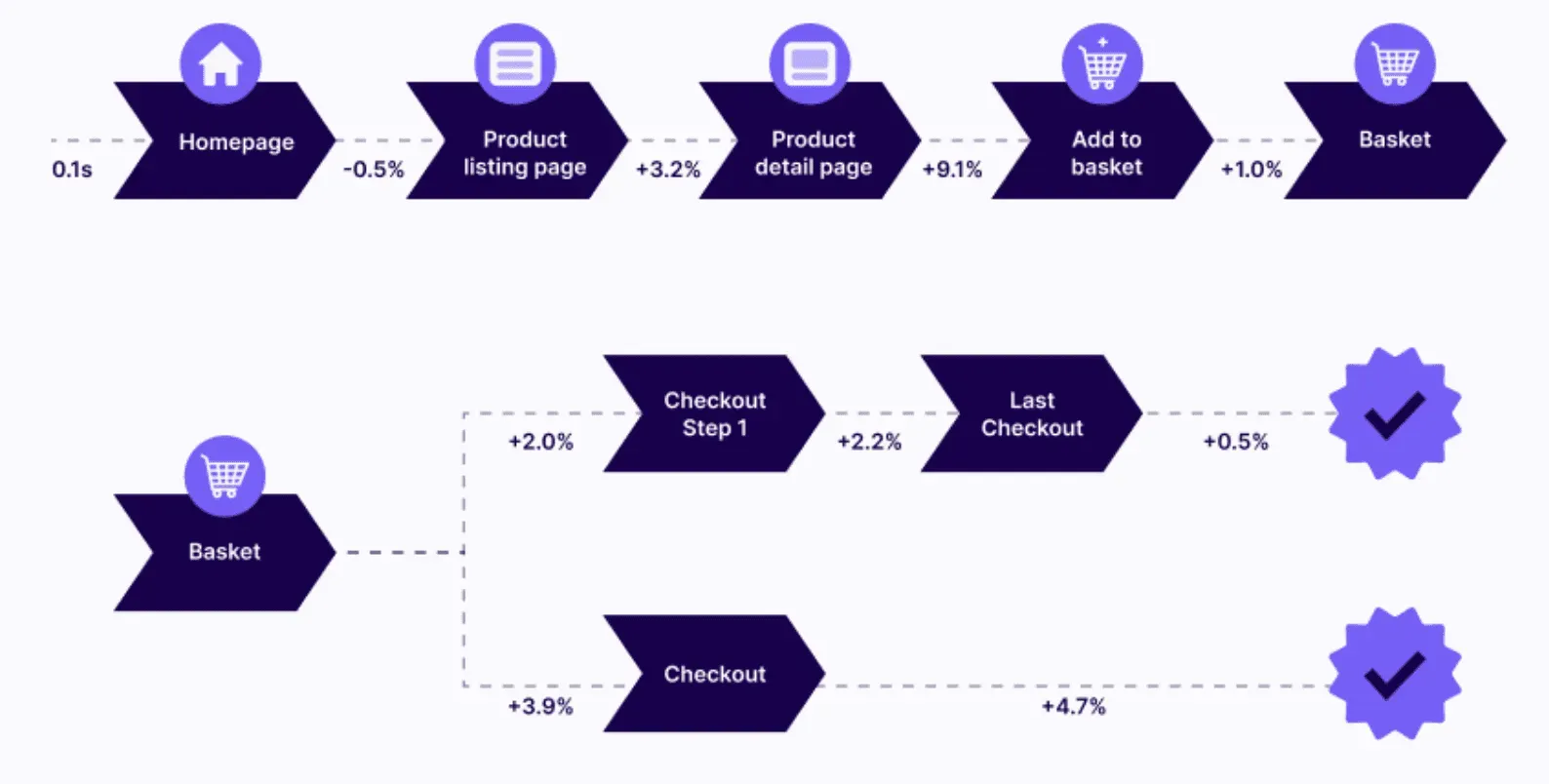
If your team’s using frameworks like React or Vue, run your site through Google Lighthouse and Google Search Console. Check how your JS renders. Fixing even minor blocking scripts can make your Core Web Vitals jump overnight.
3. Keep Your SaaS Site Secure, Accessible, and Error-Free
Trust is everything in SaaS, especially when your users share data, payments, and credentials.
Search engines reward that trust, too. Technical issues like broken redirects or mixed content tell Google your site isn’t fully reliable. That’s a problem both for rankings and for brand perception.
Here’s how to stay clean and compliant:
- Enforce HTTPS on every subdomain and environment.
- Redirect HTTP to HTTPS automatically to maintain authority.
- Audit regularly for broken links, redirect chains, and 404s.
- Ensure accessibility; alt text, ARIA roles, contrast, and semantic HTML all count.
- Keep your sitemap and robots.txt aligned with live content.
The problem is, your web developer or publisher may not know how to do all this. That’s why you need an SEO agency to keep things in check and keep track of all the minutiae.
For example, publishers can omit alt text because it’s a time consuming practice. But in some countries, like the EU, missing this can bring up 5-figure fines.
That’s why we always add alt text in the writing phase for all our clients:

The goal here is simple: no broken paths or dead ends.
Every redirect and every page status code should be intentional.
Remember, even small things like missing SSL encryption or lazy redirects can cost you trust with both users and bots.
Beyond protecting rankings, clean technical hygiene helps to build confidence for buyers, partners, and investors.
4. Turn Metadata and Schema Into a Growth Lever
Metadata is where technical precision meets strategy. It’s your first handshake with both users and search engines, and for SaaS, it can make or break how you show up on SERPs.
When your title tags and schema markup align with search intent, you control the narrative of how your product appears and who clicks first.
Here’s what to optimize:
- Build scalable templates for titles and meta descriptions across product and feature pages.
- Match metadata to SaaS-specific intent: benefits, solutions, integrations.
- Implement structured data (SoftwareApplication, Product, FAQPage) to stand out in results.
- Use JSON-LD for markup; it’s cleaner, faster, and more reliable for search bots.
- Keep metadata consistent during new product launches and rebrands.
In one case, adding FAQ schema lifted SEO impressions by 24% and got over 300 new AI mentions:
So, think structure over style; metadata and schema build clarity. They’re technical trust signals that tell search engines you’re organized and show users your content matches their intent.
Done right, they boost search engine visibility, click-through rate, and conversions in one move.
5. Master International SEO Without Breaking Structure
SaaS scales globally by nature. But expanding to new markets without a solid international SEO setup is like building a skyscraper on sand: you’ll rank nowhere.
Each region, language, and URL variation must be technically aligned to avoid cannibalization and confusion for search bots.
So, keep it clean and consistent:
- Implement hreflang tags correctly for every region and language. We’ve written an entire guide about it here.
- Localize URLs, metadata, and content; don’t just translate.
- Maintain a consistent folder or subdomain structure across markets.
- Test indexation for all localized pages after deployment.
Strong international SEO in SaaS starts with structure and consistency across regions.
When done wrong, your US and EU pages fight each other in rankings. Meanwhile, when done right, each version strengthens global authority and local trust.
6. Choose Sub-domain or Sub-folder the Smart Way
This one divides teams. Marketing wants everything under one domain for authority flow, while devs prefer sub-domains for clean separation.
There’s no universal answer, but there is a smarter way to decide based on what drives performance.
Here’s the rule of thumb:
- Use sub-folders for content, blog, and marketing assets. It consolidates SEO equity.
- Reserve sub-domains for functions like app, docs, or support.
- Keep tracking and analytics consistent across both.
- Monitor how link metrics shift after migrations or rebrands.
Here’s why it matters: splitting domains means splitting authority.
For most SaaS companies, housing your blog under /blog/ instead of blog.yourdomain.com gives search engines one stronger entity to rank.
But if you’re managing complex applications or multi-region setups, sub-domains can make sense for stability.
The key? Pick one model and stick with it. Switching mid-growth cycle can set you back months.
P.S.: Want your authority to scale with your structure? Check our list of the best SaaS link building agencies and keep your domain equity growing.
7. Monitor and Automate Technical SEO to Stay Ahead of Issues
In SEO, the technical side never stays finished; it needs regular care.
SaaS platforms evolve nonstop, and every new feature, redirect, or release can break something quietly in the background. Automation is how you catch those issues before traffic or conversions drop.
Here’s your recurring checklist:
- Run scheduled audits with tools like Screaming Frog, JetOctopus, or Ahrefs. For example, Screaming Frog is trusted by 92% of SEOs for crawling and 88% for full audits. That’s because it scales, just like your site should.
- Track Core Web Vitals, crawl stats, and index coverage monthly.
- Set up automated alerts for broken pages or sudden crawl anomalies.
- Create a workflow that connects SEO and dev teams for fixes.
But keep your expectations in check.
As noted in Aira’s report, 44% of SEO pros say technical changes take up to 3 months to show results, while 33% say 6 months.
Translation? This is a long game.
Automate what you can, document everything else, and never stop monitoring.
The SaaS brands winning organic traffic are the ones who treat SEO like continuous system maintenance, not like a quarterly sprint.
P.S.: Looking for tools that scale your audits and automate crawl checks? Here’s a rundown of the top SaaS SEO tools to keep your platform fast, indexed, and error-free.
Common Technical SEO Mistakes in SaaS
SaaS teams don’t usually ignore technical SEO on purpose.
The issue is that small technical oversights can snowball into massive organic losses before anyone even notices.
Here are the biggest culprits we see on SaaS sites:
- Over-reliance on JavaScript without proper pre-rendering leaving key content invisible to search bots.
- Broken redirects after product launches, migrations, or rebrands.
- Staging or testing environments accidentally indexed, creating duplicate content issues.
- Missing canonical or schema markup on high-value pages like pricing or product features.
- Performance drag from script-heavy setups, analytics tags, or chat widgets is bloating load times.
Each of these errors looks small in isolation. Together, they undermine crawlability, confuse Google, and burn through your crawl budget.
The fix for them? Build technical SEO into your release cycles. Treat it like QA for visibility; it’s cheaper to prevent than to recover.
P.S.: Need expert help tightening up your site’s foundations? Meet the best technical SEO agencies that help SaaS teams prevent crawl issues before they hit growth.
Turn Technical SEO into a Continuous System with Bluethings
In SaaS, technical SEO belongs to the infrastructure layer, not the to-do list.
Every new feature, landing page, or migration changes how search engines read your site. If your technical layer isn’t stable, your growth isn’t either.
Here’s the mindset shift: don’t treat SEO as a department, treat it as a system. It’s what keeps marketing, product, and engineering aligned around a site that loads fast, scales cleanly, and converts consistently.
At Bluethings, we’ve seen SaaS brands go from crawl issues to compounding growth just by fixing their foundations. That’s what we do as a full-service SaaS SEO agency, making sure your growth doesn’t stall as your product evolves.
If you’re ready to scale without breaking what’s already working, get in touch.
FAQs
What is technical SEO for SaaS websites?
Technical SEO for SaaS is all about how search engines crawl, render, and index your platform. It covers everything behind the scenes: site architecture, speed, schema, and security.
Think of it as the infrastructure that makes your search engine optimization strategy scale instead of stalling.
Why is technical SEO important for SaaS companies?
Because SaaS sites evolve fast. New features, pricing pages, and resources launch constantly. Without a clean technical setup, you create indexing issues and lose visibility.
Technical SEO keeps your site fast, structured, and accessible, improving user experience and helping your organic traffic and signups grow predictably.
How does SaaS SEO differ from traditional SEO?
Traditional SEO focuses on static content. Meanwhile, SaaS SEO deals with dynamic platforms, changing URLs, and app-like frameworks that can confuse Google bots.
You’re optimizing a living product, not a brochure site. That’s why crawl management, rendering, and automation play a bigger role across the SaaS industry.
Which technical SEO strategies are most effective for SaaS businesses?
Start with the essentials: a scalable site architecture, optimized Core Web Vitals, and structured data on key pages. Add automation for audits, error tracking, and internal linking structure updates.
Once your system runs smoothly, everything else, from content strategy to conversions, improves naturally.
What are the common technical SEO challenges faced by SaaS websites?
This is the big three: technical debt, JavaScript rendering, and fragmented sub-domain setups. SaaS companies often push product updates faster than SEO can catch up. That leads to broken links, inconsistent sitemaps, and lost search rankings momentum.
How can SaaS companies optimize crawlability and indexing for their platforms?
Use a dynamic XML sitemap, smart robots.txt rules, and canonical tags to guide search engines. Make sure your important landing pages (pricing, demo, and blog) stay easily discoverable. Regular audits catch crawl errors early before they hurt rankings.
How do server performance and loading speed affect SaaS SEO?
They’re directly tied to rankings and conversions. Slow response codes or high page loading time kill both.
A one-second delay can drop conversions by 7% and page views by 11%. That’s why site speed optimization and stable hosting should be treated as core SEO work, supported by tools like Google Analytics 4 for tracking technical performance.
What technical SEO tools are recommended for auditing and improving SaaS sites?
Start with Screaming Frog for crawling, Google Search Console for index health, and Google Lighthouse for performance. Add Ahrefs or JetOctopus to track ongoing issues.
Also, automate reports wherever you can, because manual checks don’t scale when your site does. Strong domain authority and smart link-building strategies grow naturally when your foundation is technically solid.

